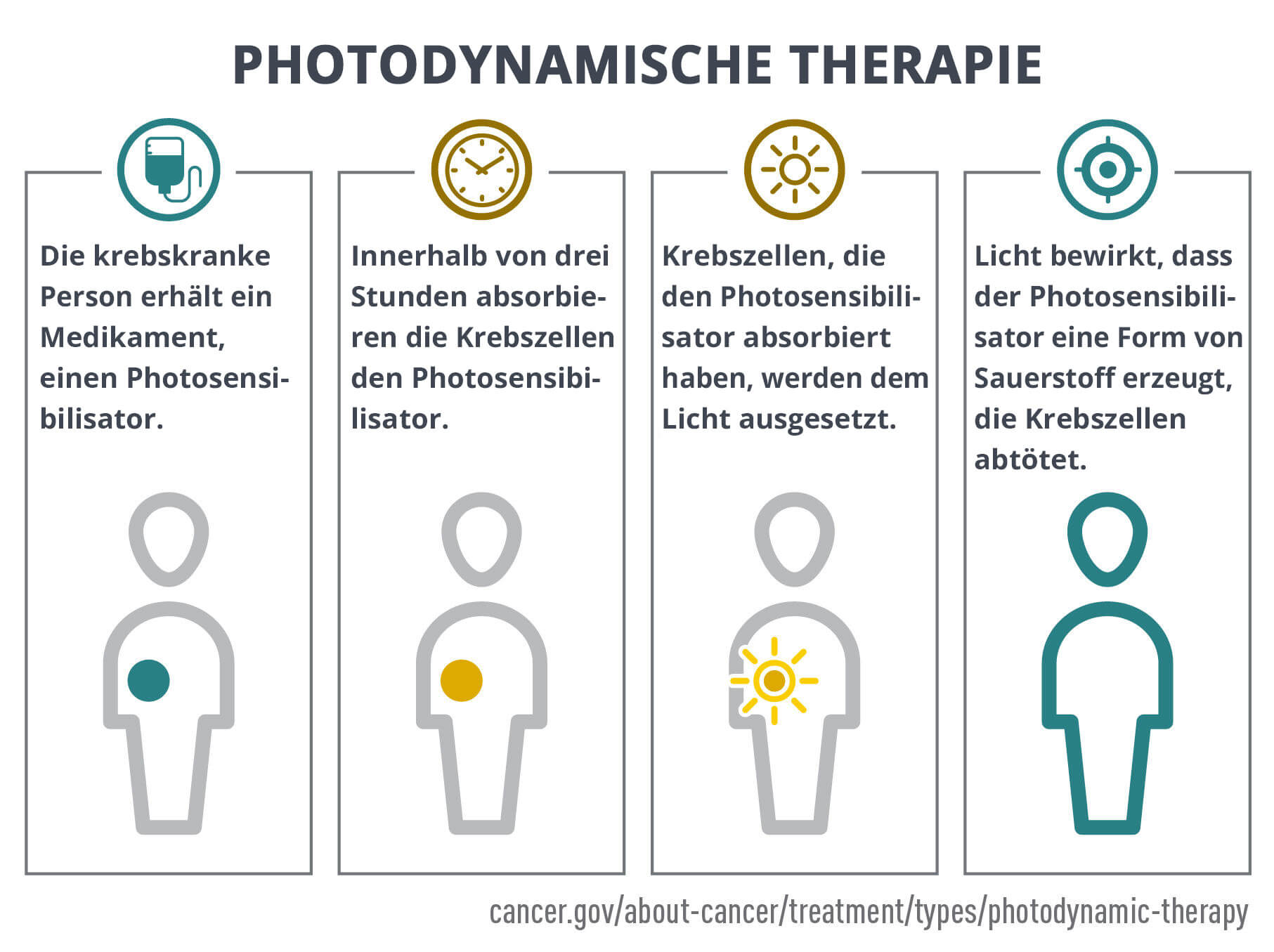How does photodynamic therapy work?
A therapy that uses light and photosensitizing substances to specifically treat diseased tissue.
Photodynamic therapy (PDT) uses natural dyes and light to gently destroy cancer cells. The dyes are called “photosensitizers” or “photosensitizers” (PS) because they are taken up into cancer cells and make them sensitive to light of certain wavelengths.
Photodynamic therapy has a long history of nearly 100 years and has been used successfully for some time to treat a variety of tumors. In particular, superficial tumors in the skin, lungs, intestines and urinary bladder are easily accessible to the irradiated light. However, tumors in solid organs such as the kidney or prostate can also be treated with PDT.
How does PHOTODYNAMIC THERAPY FOR CANCER work?
Free radicals activated by light attack the cancer cells and destroy them.
When a cancer cell that has taken up the photosensitizer is irradiated with light of a certain wavelength, the light energy triggers chemical processes that lead to the formation of oxygen compounds, especially oxygen radicals, which are highly toxic to cells and kill the cell.
In general, photosensitizers are initially taken up by all cells. But the accumulation of PS in tumor cells is higher than in normal body cells, so that, depending on the type of PS, 10-20 times higher concentrations can be reached in cancer cells. Accordingly, when irradiated with light, tumor cells primarily die off, while normal cells survive.
Depending on the PS and type of treatment, PDT may also damage blood vessels in the tumor, cutting off the blood supply to the tumor, without which the tumor cannot grow.
In addition, PDT triggers an immune response against the tumor cells by causing the dying tumor cells to release tumor antigens that are recognized by the immune system – similar to a vaccination. These tumor antigens enable the killer cells of the immune system to find and destroy the tumor cells in the body.
Call us now on +49 (0)177 23 82 863 or get in touch using the contact form
How is photodynamic therapy performed?
Light of a certain wavelength is the key.
PDT is a two-step process. First, the photosensitizer is applied, usually by intravenous infusion.
Three hours after administration of the photosensitizer, the PS has accumulated in cancer cells. By this time, however, the PS has already left normal cells – through metabolic and/or transport processes.
In the second step, the cells are exposed to the light of a specific wavelength absorbed by the PS, which activates the PS and destroys the cell. Due to the selective accumulation in the cancer cells, primarily the tumor is destroyed, while normal tissues and cells are spared.


Advantages of photodynamic therapy
The gentle PDT procedure offers patients many advantages.
- PDT primarily destroys tumor cells and spares normal cells and tissue.
- In addition, PDT destroys cells without heating, unlike widely used thermal ablation techniques such as radiofrequency ablation (RF ablation) and High-Energy Focussed Ultrasound (HiFU). Thus, PDT preserves the tissue infrastructure of fibers and interstitial matrix, as well as nerves and vessels.
- This enables functional preservation of anatomical structures: in the treatment of the prostate, among other things, preservation of the erectile function of the penis by preserving the neurovascular bundle, a vascular and nerve plexus on the prostate that is destroyed during HiFU treatment or surgical removal of the prostate.
- The bladder sphincter can also be preserved during PDT treatment, even with partial infiltration by tumor tissue if necessary.
- Also, PDT minimizes scarring and induces strong secondary immune effects against cancer cells.
Potential side effects of photodynamic therapy
Although PDT is very gentle for the patient, some side effects can still occur.
Damage to normal cells from PDT, although limited, can result in burn-like symptoms, swelling, pain, and scarring in the treatment area. Other potential side effects, depending on the area of the body being treated, include:
- Cough
- Difficulty swallowing
- Stomach pain
- Pain when breathing
- Shortness of breath
- Skin problems such as redness, stinging, swelling or itching
Photodynamic therapy with chlorin E6 for prostate cancer
Chlorin E6, a photosensitizing drug, is used to mark cancer cells.
In PDT of the prostate, light guides are inserted into the prostate at regular intervals via the pelvic floor – the perineum – using a stepper, an ultrasound transducer in the rectum and a perforated plate (brachytherapy grid). The light guides are typically inserted at a distance of 1 cm, as the laser light emitted has a maximum penetration depth of approx. 2 cm. The light guides are either inserted focally in the part of the prostate where the prostate cancer is located or can also cover the entire prostate if the tumor is extensive.

The photosensitizer Chlorin E6 is then injected into the patient as a short infusion. This photoactive substance is distributed throughout the body via the bloodstream, but accumulates 20 times more in tumor tissues than in healthy cells. Chlorin E6 photodynamic therapy for prostate cancer involves irradiating the tumor cells with monochromatic red laser light, which causes the tumor cells to die.
What is Chlorin E6 and how does it work?
When using Chlorin E6, healthy cells remain largely unaffected.
Chlorin E6 is a photosensitizer that specifically accumulates in tumor tissue. Green porphyrin is produced from plant material1. Chlorin E6 accumulates 20-fold more in tumor tissues than in healthy cells. If the tumor cells are irradiated (with monochromatic laser light with a wavelength of 665 nanometers – red light), the energy of the laser light is transferred to the chlorin E6 molecule.
The absorbed energy is transferred to oxygen molecules in the cell, creating oxygen radicals with highly reactive singular electrons. These oxygen radicals are highly reactive and react with biological components of the tumor cell such as the nucleus, mitochondria and cell membrane. As a result, the tumor cell loses its function and structure and dies.
Surrounding healthy cells that have not accumulated chlorin E6 remain largely unaffected by the red laser light.
The substance has already been successfully tested in a phase IIb clinical trial for the treatment of central bronchial carcinoma. In the available studies and experiences within the framework of healing trials, Chlorin E6 did not show any serious side effects.
Other photodynamic therapy methods for prostate cancer
The Tookad process
Another photodynamic therapy method for prostate cancer, the so-called Tookad method, has already been in clinical use for some time. In contrast to the photosensitizer Chlorin E6, the photosensitizer used in the Tookad procedure does not accumulate strongly selectively in tumor cells. In Tookad, irradiation with laser light primarily leads to a blockage of the blood vessels that supply the tumour. Tookad procedures therefore do not selectively kill off individual tumour cells, but rather cut off part of the prostate from the bloodstream.
Gentle treatments for prostate cancer
For which prostate cancer patients is photodynamic therapy particularly suitable?
In contrast to surgical, chemotherapeutic or radiotherapeutic procedures, PDT represents a significantly lower burden for the patient.
Although there are no clinical studies to date that indicate in which cases of prostate cancer photodynamic therapy is particularly suitable, it can be deduced on the basis of based on the fewer side effects of PDT that it is particularly suitable for the treatment of prostate tumors if the affected man wishes to avoid side effects such as impotence and incontinence.
PDT should also be considered and weighed against alternatives such as IRE or electrochemotherapy (ECT) for tumors infiltrating critical strictures such as the bladder sphincter or bladder floor.
PDT also represents a therapeutic problem-solving alternative for patients who are considered “out of treatment” in the “conventional medical sense” or for patients who reject conventional therapies.
Other cancers and precancerous lesions treated with photodynamic therapy
In addition to the treatment of prostate cancer, PDT is also used for a number of other diseases.
The U.S. Food and Drug Administration (FDA) has cleared photodynamic therapy for the treatment of the following conditions:
- Actinic keratosis
- Advanced cutaneous T-cell lymphoma
- Barrett esophagus
- Basal cell carcinoma of the skin
- Esophageal Cancer
- Non-small cell lung cancer
- Squamous cell carcinoma of the skin (stage 0)
PDT is also used to relieve the side effects of the following cancers (palliative, not curative).
- Esophageal cancer when it blocks the esophagus
- Non-small cell lung cancer when it blocks the airways

Photodynamic therapy (PDT) is then also possible with Chlorin E6 (right part of the illustration). Three hours after the injection of Ce6, the tumor cells took up the substance. Irradiation with special laser light triggers a chemical reaction in the tumors, producing singlet oxygen.

